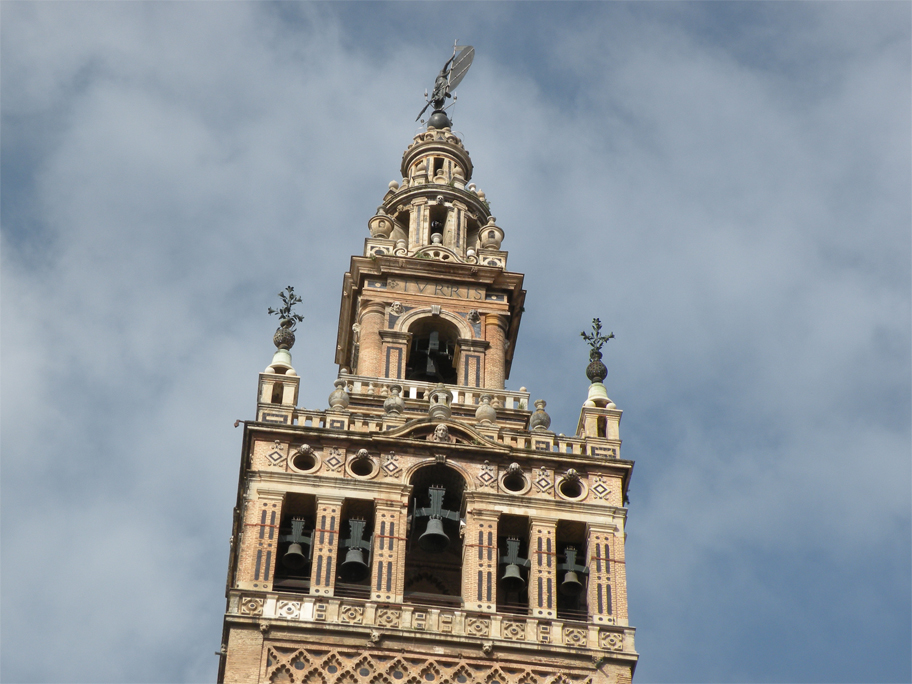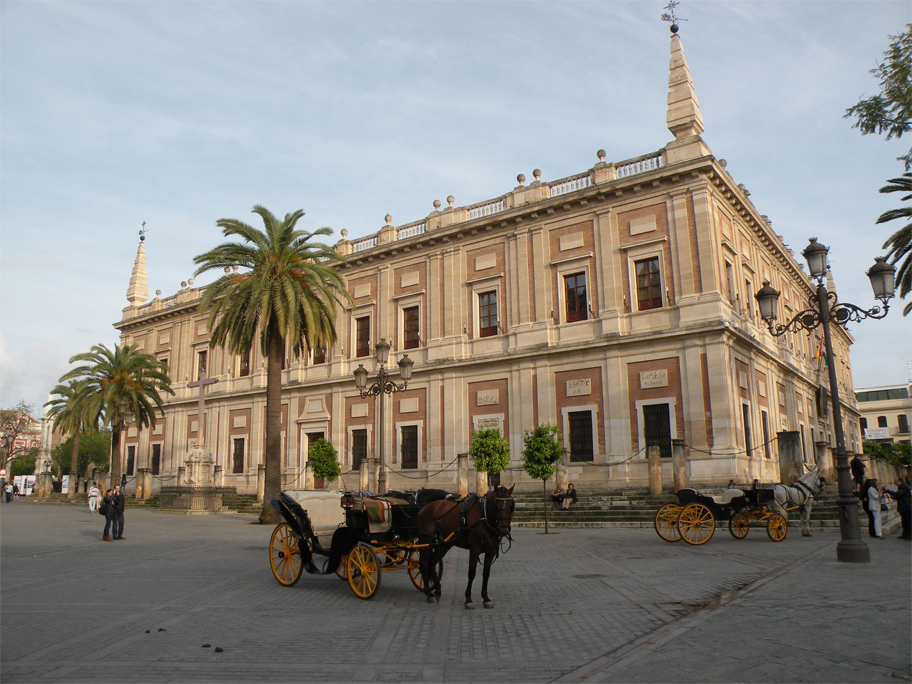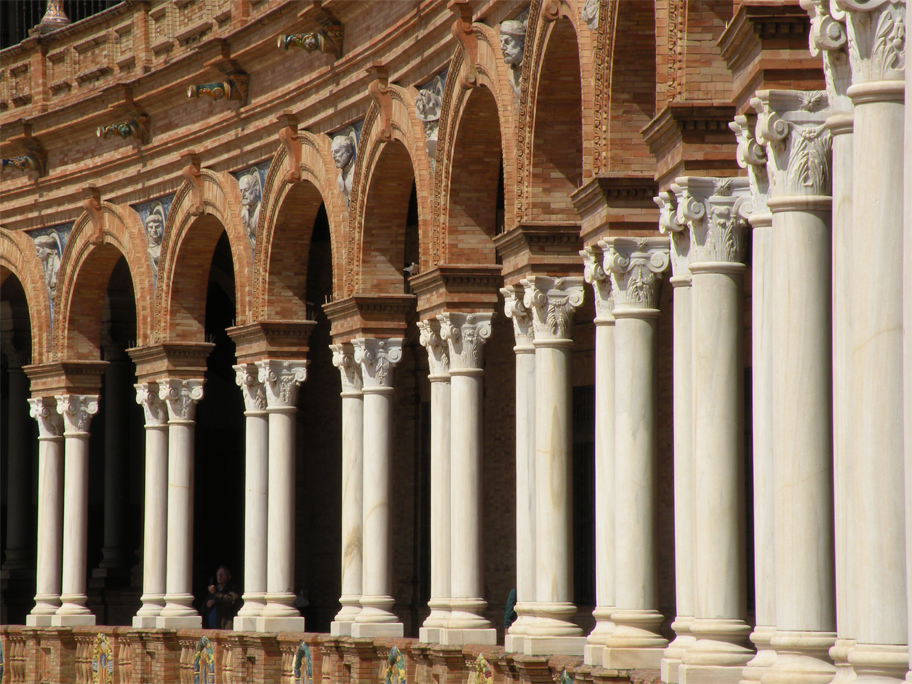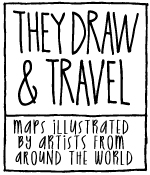Beneath the Giralda, Seville.
I had not expected Seville to feel quite so much like a European capital. The latest trams zip and down the pedestrianised avenue, whizzing past posters proclaiming the latest achievements in sustainable living. I look over at the cycle lane, its boundaries marked by a double trail of stainless steel, subtle disks stamped onto the brand-new flagstones.
It is just before noon and we are joining the queue to enter the city’s cathedral. Occupying the site of the old Almohad mosque, the enormous edifice holds the title of the world’s largest Gothic church. I crane my neck to take in its sheer scale. From the outside it appears like a fortress, a formidable bastion of the Catholic Faith.
The most distinctive part of the church is the Giralda, its bell tower and the symbol of the city. Originally built as a minaret in the late 12th century, its bottom two-thirds bear a close resemblance to contemporary structures in Morocco. Following the Christian Reconquista the minaret was converted into the cathedral bell tower, and the Renaissance crown was added in 1568. The result is a harmonious mixture of two very distinct architectural styles.
Inside, the cathedral contains a wealth of fine art and works of great historical significance. Close to the southern entrance stands the tomb of Christopher Columbus, held aloft by four lavishly-dressed figures representing the kingdoms of Christian Spain. Even harder to ignore is the vast Gothic retablo in the central nave. One of the finest altarpieces ever made, this 28 metre-high masterpiece was the lifetime work of Flemish sculptor Pierre Dancart, taking more than 80 years from start to finish.
Even with the jostling crowds, the journey up to the top of the Giralda is still worth the time and effort. From midway up the tower there is a clear view of the courtyard known as the Patio de los Naranjos. Now annexed to the cathedral, this is one of the few surviving remainders of the Almohad mosque. The reward at the very top – from a terrace just below the cathedral bells – is an unparalleled view over the city, its mass of white buildings interrupted only by the expansive gardens of the Alcázar.
The next morning we head inside the Archivo General de Indias, an unassuming Renaissance structure just across from the cathedral. Formerly the city’s exchange, it recalls a time when Seville held a tight monopoly over trade with the Spanish Americas. Together with the Casa de Contratación (the Spanish Board of Trade), Seville’s merchant guild divided much of the incoming profit from the silver mines of Peru and Mexico.
In 1785, after the base of Spanish colonial trade moved to Cádiz, the building was turned into an archive housing all the documents regarding the overseas empire. Among its vast collections there is the Papal Bull invoking the Treaty of Tordesillas – dividing the world between Spain and Portugal – and the diaries of Christopher Columbus. More than 200 years later, the General Archive of the Indies contains 8 km of shelving and 80 million pages of priceless world history, of which small portions are put on display for the general public.
Alongside the Alcázar, the archive is my favourite place in Seville. Here we stumble into a fascinating exhibition on piracy in the Spanish West Indies, complete with original navigational charts, journals and maps of colonial cities. Even after centuries in storage the papers were still brightly coloured, the ink as vivid as though it was all done yesterday.
And then there is Carlos, the cheery curator who gives us a guided tour of the entire exhibition. For more than half an hour he captures our attention, weaving stories of the Spanish Main with explanations of the precious documents on display. Most tourists in Seville give the archives a miss, but that is partially why I love it so much. It is the silence of its halls that allows every visitor to grasp its unique sense of history.
Squeezed right up against the walls of the Alcázar, it’s not easy to miss the barrio of Santa Cruz. Without a doubt this is one of the city’s most well-known neighbourhoods. Formerly the medieval Jewish quarter, its narrow streets and shaded plazas are now home to a string of restaurants and souvenir shops.
And as for people-watching, Seville has a multitude of public spaces to choose from. One that usually has it all – buskers, families with balloons, visitors and newlyweds – is the Plaza de España, a sweeping semicircular square lined by a continuous ring of government buildings. Built for the 1929 Ibero-American Exposition, the complex is a stunning example of Spanish regional architecture, featuring a monumental colonnade, a moat surrounding a central fountain, and tiled alcoves depicting all the provinces of Spain. With places like these, it’s no wonder that Seville often feels like a grand European capital.
One of the most memorable moments was our lunch on the first day, an introduction to the Andalusian specialty known as pescado frito (fried fish). It took place a fair distance north of the cathedral, at an open-air tapas bar tucked away behind a crumbling fish market. It was nondescript, the type of place most visitors would not enter for the quantity of crumpled napkins on the floor. But here in Spain dirty napkins on the floor are a sign of raw authenticity.
At the bar a friendly patron recommends a plate of salmonete (literally “little salmon”) and another one of chocos, which I remember from Tenerife. My travel companions are not so sure. “What are chocos?” they ask. With a smile the man replies, “El hermano de calamares.” – the brother of squid.
In no time our orders are served. Hands full, we retreat to our chosen seats, careful not to upset the delicate balance of our café table. Never mind the plates piled high with fishbones all around us, or the pigeons flying overhead. Both dishes, it turns out, are fried to absolute perfection.

























We didn’t climb the Giralda or go to the archives, what a pity. I am defitely going back to Seville. I loved it. Thanks for the tips.
Your blog keeps me dreaming about Spain. I just got back from a weekend in Madrid and boy, a weekend is NOT enough. I’ve only made it to Barcelona and Madrid so far but the next time I’m in Europe I’m definitely going to try to visit some of these Spanish gems.
And did you go to a “tapas” bar? haha!
Glad you love my country, James 🙂
And nice post about La Giralda and Sevilla. Believe it or not, but, being spaniard, I have not been there yet!Such a big sin! 😀
Hey James!!! When were you in Seville??? I was just there, and I recognize some of the spots you were in, as well as the wedding one. Will be so freaky if we were there at the exact same time!
p.s when do you leave spain! Let me know if you ever make it to Bordeaux!
Hi Dakota!! I was there just over a month ago, I’ve been travelling quite a lot recently so I didn’t have the time to write it up until now!
I leave Spain at the end of June, although I do have a couple of weeks to explore a bit more of Europe. France is definitely a possibility – I’ve heard good things about Bordeaux and one of my best friends lives in Lyon. So perhaps our paths will cross at some point!
Hey J!!! Thanks for commenting on my blog!!! You’re awesome. Wow, so soon… I think you’ll continue traveling though, no matter what, right?
Seville is just, really cool!
Oh cool, Lyon! Nice place!!! Yeah, for sure!!! If you’re in Bordeaux. let me know!!! I’ll show you all the cool places here. When do you think you might be here? I can show you all around the city for the day, it will be cool!!!
Wow, thanks for the offer Dakota!! If I do come to France it will be sometime toward the end of June… however none of my plans have been fixed so far. I’ll let you know how the situation develops!
Wow, James…love the photos! Not only are you taking lovely pictures but you’re adding little tidbits of the historical aspect as well. I love photos from people’s travels (as I’m sure Dakota can tell you…lol), and I’m also a pretty big history buff, so I appreciate the added info!
Great job!
Thanks Christy as always 🙂 hi hi.
XO
Some nice pictures and narrative. I was there in 2008, thanks for the memory nudge!
Hola, me ha gustado mucho tu entrada sobre mi ciudad.
He llegado a ti a traves de Dakota , asi que te seguiré, veo que eres un apasionado de los viajes¡¡¡¡
Saludos Isabel
SsasDiary
Hola Isabel, gracias por tu comentario! Me alegro de que hayas encontrado este blog, es absolutamente cierto que estoy enamorado de tu país. Todavía quedan dos entradas más sobre tu ciudad, como era tan bonita saqué más que mil fotos allí!
Un saludo
James